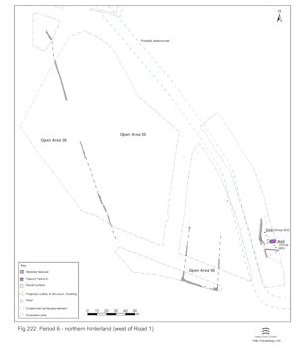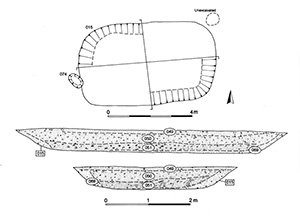
No latest Roman activity is evident within that part of the Northern hinterland to the west of the postulated northward continuation of Road 1 (Figure 222). Early Saxon activity is also absent from all but the easternmost excavated extent. It appears that almost all vestiges of earlier land division has passed out of use by Period 5, or at least is not maintained and managed. This does not necessarily mean an absence of agricultural activities during the late 4th and 5th centuries, simply that they leave no mark upon the landscape.

It is perhaps significant that all identified Early Saxon remains are located in the east, probably most significantly to the east of the postulated northward continuation of the watercourse toward the Langford Road site (Langton and Holbrook 1997). Furthermore, it is conjectured that some remnants of the earlier land division system do endure at this location, with the enclosure defined by Period 4 ditches 25187 and 25189 now being occupied by the Early Saxon occupation remains described below.
This activity may therefore denote the westernmost extent of a dispersed Saxon settlement occupying the higher ground along the north side of the watercourse, of which the structures identified in Excavation Area R and at Crescent Road (Drury and Wickenden 1982; Wickenden 1986; Roy 2003) are a further part.

Sunken-featured Building 69 is defined by rectangular cut 015, which measures 6.45m long, 3.9m wide and c. 0.55m deep (Figure 223). Its sides slope inwards at 45-65 degrees down to a flat base. Although excavated in very waterlogged conditions, a sequence of brown-grey to dark grey clayey silt fills (becoming sandier towards the bottom) is defined. These contain moderate quantities of pottery and tile, with a concentration of animal bone at the centre of the feature within the lowest deposit. Oval post-hole 074 cuts the west end of 015.
On morphological grounds Building 69 is almost certainly an Early Saxon sunken-featured building, rather than merely a large pit, with post-hole 074 and other unexcavated possible post-holes perhaps representing remains of the superstructure over it. No specific occupation deposits are identified within the SFB, the fills essentially denoting a rapid and deliberate episode of backfilling, perhaps as part of an abandonment ritual. Early Saxon pottery is present in the fills of both cut 015, and post-hole 074.
A number of post-holes in the vicinity of Building 69 (032, 060, 062, 071, 075, 081, 082, 084, 085, 088, 090, 092 Group 933) are also of possible Early Saxon date, collectively containing a few Saxon sherds in their fills. These may constitute associated structures such as fencelines, although a surface-built timber building such as those found at Crescent Road cannot be ruled out. Waterlogged conditions in this south-east corner of Excavation Area W were severe at the time of excavation and the distribution of small late features is by no means reliably complete.
Of note is the location of post-holes 081 and 082. These are positioned within the gap between ditches 25187 and 25189 (Group 912 Period 4). Although this may be coincidental, it is tempting to interpret them as some sort of gateway structure and to postulate that the enclosure either endures or is re-occupied in the 5th century.
Internet Archaeology is an open access journal based in the Department of Archaeology, University of York. Except where otherwise noted, content from this work may be used under the terms of the Creative Commons Attribution 3.0 (CC BY) Unported licence, which permits unrestricted use, distribution, and reproduction in any medium, provided that attribution to the author(s), the title of the work, the Internet Archaeology journal and the relevant URL/DOI are given.
Terms and Conditions | Legal Statements | Privacy Policy | Cookies Policy | Citing Internet Archaeology
Internet Archaeology content is preserved for the long term with the Archaeology Data Service. Help sustain and support open access publication by donating to our Open Access Archaeology Fund.